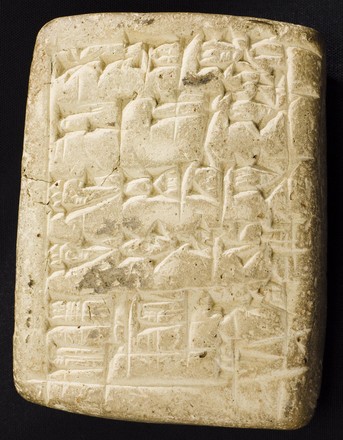The
State Library of New South Wales in Sydney has a tablet in its Rare Books
collection. According to the records of the then Principal Librarian, William
Herbert Ifould, OBE, the tablet was donated to the State Library on 21 February
1940 by Mr J Yared who had migrated from Syria and was then a resident of
Maryborough in Queensland. At the time it was thought to be a replica, but
inspections by Dr Noel Weeks in March 1975 and Dr Larry Stillman in August 1983
identified the tablet as genuine.
The
inscription is in Sumerian and dates to the reign of Sîn-kašid (c1860 BCE) who
ruled the city of Uruk, located in the south of modern-day Iraq. The tablet was
baked, which is a significant factor in its excellent state of preservation. The
inscription records the king’s name, titles and epithets and states that he
built a royal palace. There are many other known examples of this inscription recorded
on a variety of objects, including bricks and clay cones.
It
is certain that this artefact was once among the many similar tablets and clay
cones bearing this inscription that were recovered from the foundations of
Sîn-kašid’s palace at Uruk. These objects functioned as foundation deposits and
were placed on every fourth course of bricks during construction. The purpose of doing so was to ensure that when the mud-brick palace needed
renovation over the future centuries, Sîn-kašid’s name and deeds would be read
by his successors and his legacy would survive.
Bibliography
D
Charpin, DO Edzard, and M Stol, Mesopotamien:
Die altbabylonische Zeit (Orbis Biblicus et Orientalis 160/4), Academic
Press Fribourg, 2004
RS
Ellis, Foundation Deposits in Ancient
Mesopotamia (Yale Near Eastern Researches 2), New Haven: Yale University
Press, 1968
D
Frayne, Old Babylonian Period (2003 –
1595 BC) (Royal Inscriptions of Mesopotamia, Early Periods 4), Toronto:
University of Toronto Press, 1990
AR
George, House Most High: The Temples of
Ancient Mesopotamia (Mesopotamian Civilizations 5), Winona Lake:
Eisenbrauns, 1993
AR
George, Cuneiform Royal Inscriptions and
Related Texts in the Schøyen Collection (Cornell University Studies in
Assyriology and Sumerology 17 / Manuscripts in the Schøyen Collections
Cuneiform Texts 6), Bethesda: CDL Press, 2011



 Back to list
Back to list